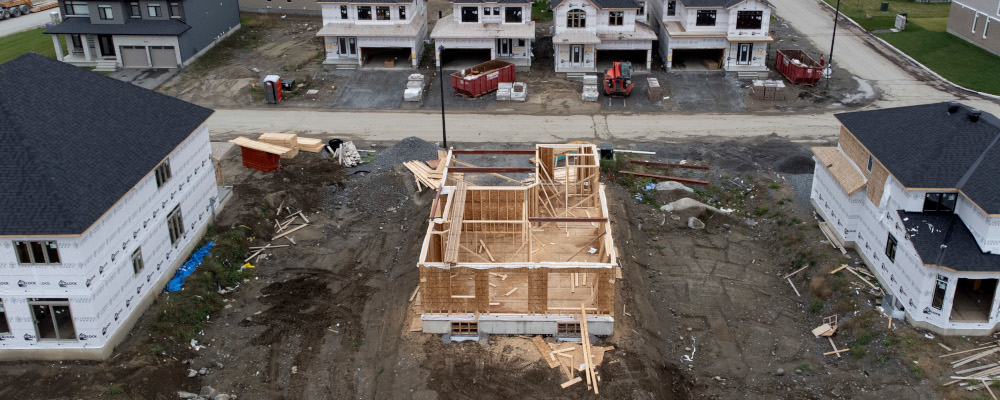Canada has the fewest homes per capita of any G7 country, and Ontario is tied with Alberta for the fewest homes per capita of any Canadian province.“Canada has a structural housing shortage. This is by now very well established. Last year, we provided some insight into this shortage by comparing the number of dwellings per capita in Canada to that of other G7 countries. That analysis found a large gap between Canadian outcomes and those of our peers. While purely indicative, the analysis pointed to our collective failure in right-sizing the number of homes relative to our population. That work noted that we would need an additional 1.8 million dwellings in Canada for us to have the same number of homes per capita as other G7 countries.” https://www.scotiabank.com/ca/en/about/economics/economics-publications/post.other-publications.housing.housing-note.housing-note–january-12-2022-.html
For Ontario to catch up to just the average G7 country, we would need to see about 1,000,000 housing units completed overnight—and this is before accounting for any population growth.
Over the past ten years, we’ve seen about 70,000 completions per year.
It’s no wonder that housing is so expensive in this province, and in our major cities in particular.
Back in December, when we had six months to go until the provincial election, I floated a few policy proposals that would allow for much more housing to be built. I hoped that some of those might be picked up by the Province’s Housing Affordability Task Force.
Since then, in early February, the task force released a report that includes 55 bold ideas, starting with a proposal that the Province adopts a target of 1.5-million housing completions over the next ten years.Report of the Ontario Housing Affordability Task Force
In response, last week, on March 30th, the Province introduced the More Homes for Everyone Act, which includes a number of positive but fairly modest provisions.
None tackle the restrictive municipal land-use rules that make it effectively impossible for us to build the volume of housing we need.
Per the Province’s news release:
“We heard from municipalities that they aren’t ready to implement ambitious policies from the Task Force’s report right now.”
A full reading of the release does however suggest that the Province might have the appetite for bolder, perhaps less popular, action following the election when a second mandate has been secured. A key excerpt:
“The Task Force report is our long-term housing roadmap. Similar to Ontario’s approach with regular Red Tape Reduction bills, the province is committed to implementing the Task Force’s recommendations with a housing supply action plan every year over four years, starting in 2022-2023, with policies and tools that support multi-generational homes and missing middle housing.”
In anticipation of that bolder move, I’m updating the set of priority recommendations I made in December with a few more, pulling from a recent transition paper I wrote for Ontario 360.It’s Time To Build: Liberalizing Ontario’s Land Use Rules To Boost Market-Rate Housing Supply
Some of these repeat recommendations made by the Housing Affordability Task Force, and some are new. Taken as a whole, they’re disruptive enough to the status quo that they should be prioritized and implemented within the first 100 days following the election.
First, the Province should set standards requiring that all municipalities update their official plans and zoning bylaws to repeal or override all policies that prioritize the preservation of the physical character of their neighbourhoods.
This is to address the explicitly stated objectives in many municipal planning documents to preserve the stability and maintain the existing physical character of established neighbourhoods. In practice, this means that we see a lot of small old houses getting replaced with new big houses in many of our neighbourhoods, but no intensification and no additional units, despite strong demand.
Second, the Province should set standards requiring that all municipalities update their official plans and zoning bylaws to allow for a minimum of four residential units on all residential lots or six residential units on all residential lots within a population centre of 500,000 or more people.
Third, the Province should set standards requiring that municipalities update their official plans and zoning bylaws to not include any maximum heights lower than 12 meters. (That’s four storeys.)
Fourth, the Province should set standards requiring that municipalities update their official plans and zoning bylaws to end the practice of limiting permitted densities through a Floor Space Index (FSI) constraint.
The FSI is the ratio of the total permitted floor area of a building to the total lot area. So, for example, a 20 foot by 100 foot lot with an FSI of 0.6 would only allow for 2,000 sf * 0.6 = 1,200 sf of floor area in a new building—even if the form-based criteria (such as height and depth) would appear to allow for much more.
The FSI has got to go.
Two of these recommendations are repeated from my December piece. Taken all together, they would unlock the missing middle—housing types that are denser than a semi-detached house and less dense than a midrise building—and lead to a boom in small-scale development.
I’ve written another Hub piece here with my friend Brendan Whitsitt on why that’s a really good idea.“Why are these types of housing called ‘the missing middle?’ Because they fit into the ‘middle’ range of density, between detached houses on one end and midrise buildings on the other. At one time they were the predominant form of housing in many cities, but they’ve been ‘missing’ from new development since around the post-war era. At that time, increasingly restrictive zoning ordinances started setting aside large swathes of our cities for only detached houses. This has effectively reduced population in many of our most established city neighborhoods, even as overall urban populations have grown.” https://thehub.ca/2021-06-18/opinion-canada-can-build-millions-more-homes-by-unlocking-the-missing-middle/
They wouldn’t, however, do much to allow for efficient, higher-density buildings. They are necessary but not nearly sufficient.
We’re also going to need a lot more new midrise and highrise development.
I’m focusing on the missing middle here because these policy changes would distribute development more broadly beyond urban centres and transit notes, exhaust local NIMBY opposition through sheer volume, and, critically, draw from a broader and more accessible talent pool for development and construction.
They would help us chip away at our housing deficit and revive the dream of homeownership for young, middle-class, and immigrant families.
Recommended for You

Falice Chin: A tale of two (Poilievre) ridings

Evan Menzies: Calgary at 150: Why is it so hard to celebrate our history?

‘We’re winning the battle of ideas’: Conservative MP Aaron Gunn on young men moving right, the fall of ‘wokeness,’ and the unraveling of Canadian identity

Laura David: Red pill, blue pill: Google has made its opening salvo in the AI-news war. What’s Canadian media’s next move?




